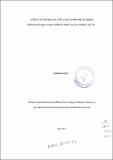| dc.description.abstract | An experiment was carried out in two sites namely: Machang’a Secondary School Farm, and in a nearby former KARI site about a kilometer apart, all in Kiritiri division - Mbeere South Sub-County, 10 and 11km southeast of Kiritiri town respectively. They lie in the Agro ecological zone LM4 (marginal cotton zone) that ranges between 1000-1280 m above sea level, whereas the sites altitude is about 1080 m above sea level. The purpose was to evaluate the appropriate spacing and fertilization regime for Gadam sorghum. A Randomized Complete Block Design (RCBD) was used in the experimental sites conducted concurrently in the 2014 short rains so as to fast track the process, as well as, to guide against the possibility event of failed 2015 long rains due to their erratic nature, which would have ultimately led to lack of results data. Three different spacing treatments were subjected to four different fertilization levels/regimes. Primary data collected was compared and analyzed using Statistical Package for Social Sciences (SPSS ver. 22). The results showed that there were significant relationships in the interactions between the spacing treatments and fertilization regimes. The application of fertilizer significantly affected grain weight, leaf length and the above ground biomass at the 100 kg/ha fertilizer level and 75x30 cm intra-row spacing an indication of healthy crop growth and yield. High number of leaves lengths per plant at fertilizer application 100 kg/ha may have provided more surfaces for photosynthesis and assimilates production adequate for growth and yield and thus optimum grain weight. Considering the main effect and interaction, spacing at 75x30 cm showed to favour the growth and yield of the Gadam sorghum, under the Mbeere South Sub-county. From this study therefore, and for economic reasons, the 100 kg/ha fertilizer level, and 75x30 cm intra-row spacing, can be recommended for sorghum production in this Sub-County. | en_US |

